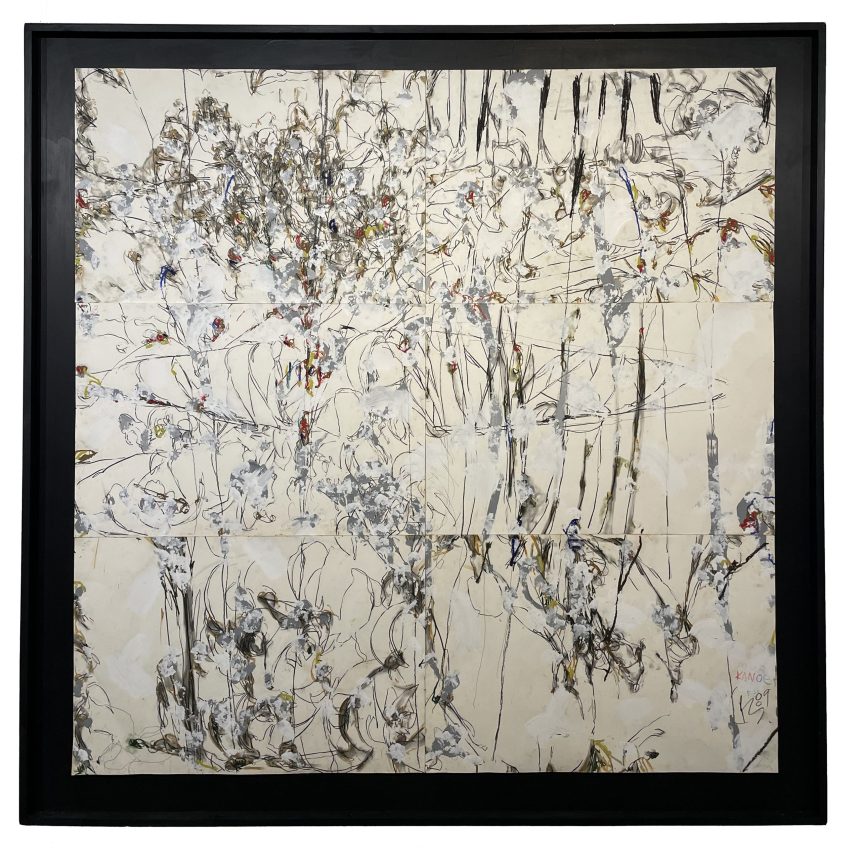The Appearance of Art: Roger von Golling at Sixty Bowls

At its current point on the gentrification/revitalization arc, Hingetown might seem an unlikely place to find a new commercial art gallery, and even more so one selling works by an artist who has never before had a proper show. That’s the situation at Sixty Bowls Gallery, though, where you can find Roger von Golling’s first ever exhibition, The Appearance of Art, through the end of May.
The show consists of drawings on paper, mostly oil pastel, with pencil and charcoal. It’s mostly abstract mark making, though there are a few landscape sketches available in bins of work that didn’t make it to the walls. If you think of moving shapes when you hear music—climbing, crashing, screeching jumbles of lines and color—you’ll find it easy to relate. Viewers can bring to abstraction whatever they like, and if they are inclined, can find there much more than ideas about composition or technical matters. Struggle? Sure. Bewildered confusion? Check. But these have a back-story that is worth knowing, and not only because all art is enriched by a little knowledge about who made it. In this case, the situation informs the technique and the results.

Roger von Golling was born in Cleveland Heights in 1946, and raised in Lakewood. He attended Ohio University. While caring for his mother in 1974, he took up drawing. He moved around a lot. He eventually attended the Cooper School. In the 80s he was an artist in service to the Cleveland rock scene, making sets, backdrops, flyers, and album art primarily for the band Lucky Pierre, primarily at the Phantasy complex. He says he left Cleveland multiple times and has lived and worked in seven major US cities. By his own estimate he has hitchhiked 10,000 miles and held 68 jobs. Those included a whole lot of cook and chef gigs in a broad spectrum of restaurants, from the Ritz Carlton in Chicago to—in his words—the “dregs of rock clubs in the Flats.” He also did stints as an assistant editor at Little, Brown Co., on Great Lakes ore boats, designing displays at Higbees’ old Downtown Cleveland store, as a garbage man, as a palm tree trimmer in Miami, and on and on. He was homeless “a lot.”

He left Cleveland permanently in 1990 for Boston, which he calls his “lucky town,” where he currently lives. In Boston he lived for a while in a boarding house, where he says he tried to “really understand [his] ability and direction in art.” He was in his fifties, age-wise. And under those circumstances, in a small room, he developed a technique of drawing on individual sheets of paper, sketch pad-sized. That’s what he had space for. He’d mark the sheets intuitively, in a given palate and style of line, and they would accumulate into forms. And then each sheet would become part of a whole, usually six together, fitting not always seamlessly, but with lines and forms crossing from sheet to sheet, coming together to make the overall work.

Von Golling says the technique of working on sections of larger works one by one and assembling them was “born of poverty.” “It’s not something I swear by,” he says. “It was done out of necessity, and I always wanted to do big drawings. I did have some wall space there in that decrepit room. … All this busy detail stems from my rebellion to instantaneous texture and dots, etc. … The filler, so to speak, becomes the content. I am trying to keep it simple. [That’s] the hard part.”
The strongest of these works are the largest—the ones created in pieces in that little room. It’s as if the nature of the vision, and the proportion of the marks and lines, needs all that space to fulfill their promise. Who knows how these would be if they were created at the same scale on single, large sheets—but the fact that they are realized this way under confining circumstances is defiant of the conditions in which they were brought into being. Each of the drawings comprises hundreds, even thousands of marks, made typically across half a dozen pieces of paper. The cumulative effect is like being inside the artist’s brain.
The works on view represent a tiny fraction of Von Golling’s output, and they are worth seeing before this show comes down. Sixty Bowls proprietor Gary Thomas, who curated the show, drove to Massachussets to pick up work, and brought some 300 pieces back to Cleveland. Von Golling says another show is in the works, at some yet-to-be-determined date.

The Appearance of Art
Sixty Bowls Gallery
3125 Detroit Avenue
Cleveland, Ohio
Sixtybowls.com


You must be logged in to post a comment.